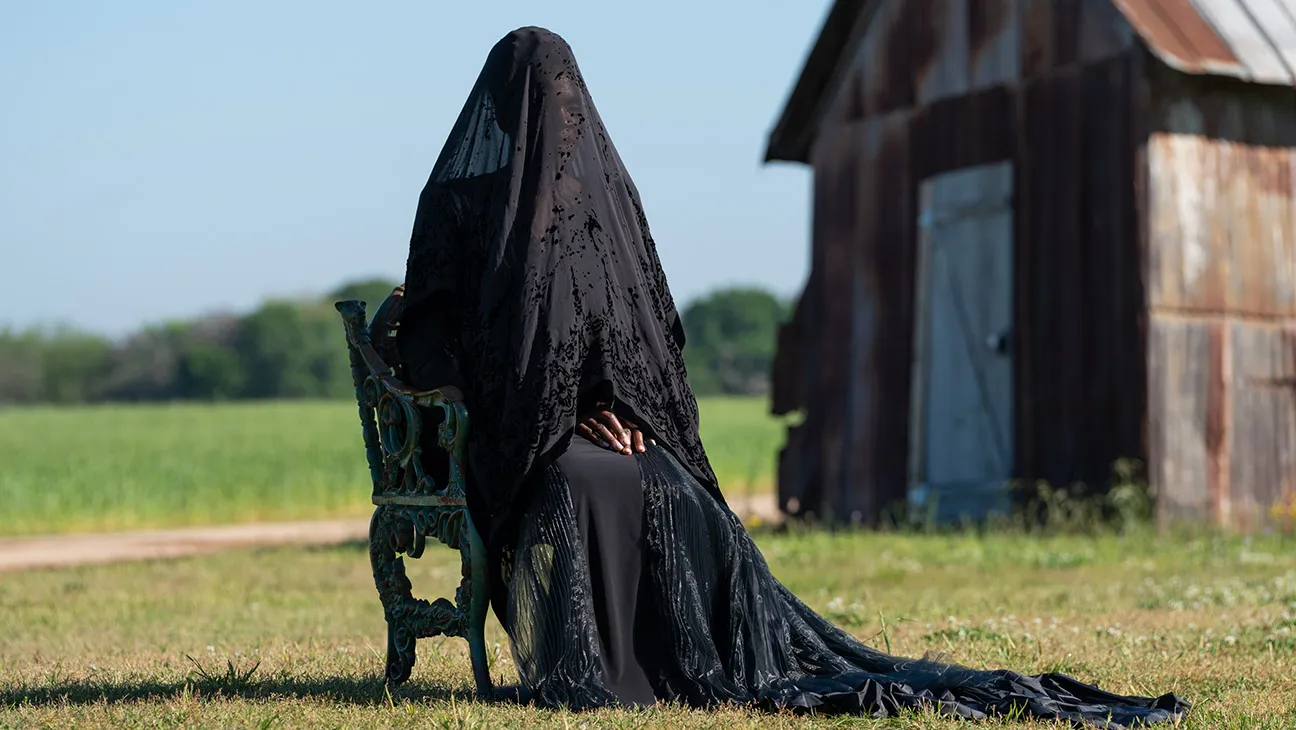Director: Jaume Collet-Serra
Writer: Sam Stefanak
Stars: Danielle Deadwyler, Okwui Okpokwasili, Russell Hornsby
Synopsis: A mysterious woman repeatedly appears in a family’s front yard, often delivering chilling warnings and unsettling messages, leaving them to question her identity, motives and the potential danger she might pose.
I’m not breaking any news when I say that all of us are going to die, and, in some shape or form, death stares at us in the face every day. When a celebrity you love passes away, it forces you to not only think about that person, but also your own mortality. After all, we are finite human beings who only exist on this Earth in passing and whose purpose is to create a series of memories that’ll make us remember who we are, in the eyes of other people, before our ultimate trip. For many, this realization that we’re not meant to exist forever is a peaceful reminder of the biggest mystery of all that awaits us on the other side. But for some people, living on this planet continuously reminds us of our deepest, most painful regrets – waking up is a bigger nightmare than falling asleep, and perhaps ending it all may be a less painful solution than the hell of carrying memories and constantly being haunted by them.
This is the central subject matter of The Woman in the Yard, a surprisingly layered and violently disturbing psychological thriller that’s so much more than the horrendous marketing will lead you to believe. In fact, the promotional advertisements you may see of the movie hide what the film is about, which, in some cases, is perfectly acceptable to shroud your project in mystery and let the audience discover the story for themselves. However, in the case of Jaume Collet-Serrra’s first venture into horror cinema since 2016’s The Shallows, the film should come with the biggest of all trigger warnings, and not as a mid-credits text, but at the very top of your movie, before it even begins.
I’m not the type of person who usually advocates for these, as most filmgoers will usually have a general idea of what the movie is about if they watch a trailer, or read the plot synopsis on IMDb, ensuring they fully understand what they’re going into before they make the choice of buying a ticket. For example, not knowing that the Terrifier franchise is filled with extreme violence, despite the promotional material heavily leaning into that specific aspect, is being very ignorant – you can’t complain about a warning when you completely ignored them in the first place! But The Woman in the Yard is different, as it directly – and accurately – visualizes how it feels, inside the subjective viewpoint of Ramona (Danielle Deadwyler), to be suicidal.
In fact, the movie contains the most harrowing depictions of suicidal ideations I’ve seen in a major motion picture, going much further than simply expressing the sorrow and perpetual pain one feels when they think their life isn’t worth living. Through the figure of “The Woman in the Yard” (Okuwi Okpokwasili), Collet-Serra and cinematographer Pawel Pogorzelski (who has two films coming out on the same day, alongside Mimi Cave’s Holland) illustrate a woman wanting to end it all, attempting to push back the lingering shadow of Death, but is so powerless in attempting to stop it that she ultimately succumbs to its darkness. There isn’t anything remotely light or even thrilling about the movie – it’s a metaphorical representation of depression and suicide of the likes that few filmmakers are actively willing to depict this way on film, because of how violent and profoundly upsetting it is.
The Woman shows up in Ramona’s yard, with little to no explanation, and soon begins to invade her house, getting closer and closer to her children (played by Peyton Jackson and Estella Kahiha) and to the protagonist, who is still reeling from the crushing loss of her husband, David (Russell Hornsby). The two were involved in a car accident – Ramona was driving, while David sat in the passenger seat. Since then, her life hasn’t been the same. She’s grown more distant with her kids, and the mere thought of David suffocates her so violently that she can’t bring herself to carry on, despite her continued calls to a higher power for strength. It’s at that point that her son realizes that “there’s a woman in the yard” and it won’t be hard for anyone to figure out who this woman represents, not only to Ramona, but in the grand scheme of the picture.
![Movie Trailer: 'The Woman In The Yard' [Starring Danielle Deadwyler] - That Grape Juice](https://thatgrapejuice.net/wp-content/uploads/2025/01/the-woman-in-the-yard-tgj.jpg)
The antagonist itself is not your traditional otherworldly figure haunting the family, but a metaphorical representation of what humans fear the most and what they constantly try to ignore in their daily lives even if it constantly stares at them in the face. For Ramona, she’s staring at it directly for the first time after trying to ignore it and move on for the sake of her children. This results in an utterly devastating series of events that, while reaching a telegraphed conclusion, still manages to shock by the time Collet-Serra and Pogorzelski conclude with the most significant image of their entire film. It never once handholds the audience or spells out the metaphor in front of them (although one doesn’t need to be versed in subtext to know who the woman is), preferring to represent Ramona’s longing anguish through the best use of expressionistic imagery seen in a horror film with a contemporary setting.
Unlike Robert Eggers’ Nosferatu, which imbued the picture with Murnau signifiers that acted as empty gestures with little to no purpose, Collet-Serra and Pogorzelski appropriate the cineaste’s use of shadows to create a disturbing showcase of a death portent, where each deliberate act by the woman is meant to afflict Ramona until she loses all sense of self. It creates an unforgivingly dire atmosphere that only amplifies in intensity as the protagonist realizes there is no way out of this predicament but committing the unthinkable. It’s at that point where Collet-Serra brilliantly distorts perspective, blurring the lines between her imagination and the harsh, cruel hell of reality, never knowing if what she sees is happening for real or a fragment of her darkest memories, bringing back events she doesn’t want to think about – or even merely acknowledge.
In representing this never-ending pain, Danielle Deadwyler continues to prove why she’s one of the very best actors working today, whose work will transcend generations. There’s a specific moment that occurs near the end in which she recalls to her son what happened with David, and she simply uses her eyes to express everything she has been feeling inside ever since the loss of her husband, where it’s hard to pull back tears. What does it mean to live in this world, when the people you love most are not only gone, but whose voices have now been completely forgotten? My grandfather died seven years ago, and, when our family digitized an old VHS with a video featuring him, I had entirely buried what he sounded like. Ramona continuously remembers the best parts of the time she spent with David, but as his voice only becomes a distant memory, and warps itself with the most regretful moment of her life, these memories become unreliable and agonizing.
As a result, this forces Collet-Serra to rethink classic horror movie devices as not simple “gotcha!” moments, but a part of Ramona’s psyche. The jumpscares are the most petrifyingly effective I’ve seen in ages (I can’t remember the last time I genuinely jumped out of my seat in terror like that), acting as the living embodiment of the Hell Ramona believes she is living in, becoming much harder for her to “snap out of it.” She believes there is no way out but death, and this clouds her judgement so much that she can never realize this perceived ending will only bring more suffering to the people she loves most, and who want her to move on, for their sake.
In some ways, this is Collet-Serra’s As I Was Moving Ahead Occasionally I Saw Glimpses of Beauty. Of course, the comparison is strange, and both movies are formally distinct from one another. However, in his succession of images, each more jaw-droppingly evocative and haunting than the last, Collet-Serra urges us to remember that this life is worth living. The people we’re connected to are worth fighting for. Death will always linger like a shadow, and remind us of our fragile nature, but if we let it take hold of our minds, we may never move on. We may never hope for anything good happening in our lives again. We’ve given up and believe this is it.
But it’s not it. It can’t be. We must continue to live until it’s truly our time to go – prematurely ending it won’t solve anything. We have so much more to accomplish, still, and no matter what happens, this finite world we’re in is worth spending a bit more time in it. While I understand that some may be profoundly destabilized by The Woman in the Yard, Collet-Serra accomplishes his intended effect and guarantees you’ll never be able to wipe it off your memory and think about your life in a far more introspective way than ever before. In any event, the movie undoubtedly positions the Spanish filmmaker as one of the best genre artists working today, who, after freeing himself from the shackles of Dwayne Johnson, finally delivers his best work yet.






